A collection of videos relating to the diagnosis and treatment of eye movement disorders. This collection includes many demonstrations of examination techniques.
Dan Gold, D.O., Associate Professor of Neurology, Ophthalmology, Neurosurgery, Otolaryngology - Head & Neck Surgery, Emergency Medicine, and Medicine, The Johns Hopkins School of Medicine.
A collection of videos relating to the diagnosis and treatment of eye movement disorders.
NOVEL: https://novel.utah.edu/
TO
Filters: Collection: "ehsl_novel_gold"
| Title | Description | Type | ||
|---|---|---|---|---|
| 326 |
 |
Spontaneous Upbeat Nystagmus in Acute Wernicke's Encephalopathy | 𝗢𝗿𝗶𝗴𝗶𝗻𝗮𝗹 𝗗𝗲𝘀𝗰𝗿𝗶𝗽𝘁𝗶𝗼𝗻: This is a 40-year-old woman presenting with imbalance, confusion and oscillopsia. Exam demonstrated upbeat nystagmus (UBN) in primary gaze that remained UB in all directions of gaze, with a slight torsional component (top... | Image/MovingImage |
| 327 |
 |
Square Wave Jerks and Macrosaccadic Oscillations in a Patient with a Cerebellar Tumor | This is a 40-year-old man who developed severe headaches, confusion, and gait imbalance which led to neuroimaging which demonstrated a midline cerebellar mass with compression of the fourth ventricle and obstructive hydrocephalus. He underwent a suboccipital craniectomy for resection of the mass, an... | Image/MovingImage |
| 328 |
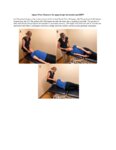 |
Square Wave Maneuver for Apogeotropic Horizontal Canal BPPV | The square wave maneuver is designed to treat individuals with horizontal canal cupulolithaisis and is commonly used when individuals have cervical restrictions and the affected side is not well identified at baseline. 1. The patient begins in the supine position with the head 20 to 30 degrees above... | Text |
| 329 |
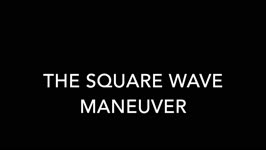 |
Square Wave Maneuver for Apogeotropic Horizontal Canal BPPV (Video) | The square wave maneuver is designed to treat individuals with horizontal canal cupulolithaisis and is commonly used when individuals have cervical restrictions and the affected side is not well identified at baseline. 1. The patient begins in the supine position with the head 20 to 30 degrees above... | Image/MovingImage |
| 330 |
 |
Subtle Torsional Pendular Nystagmus in Oculopalatal Tremor (OPT) | 𝗢𝗿𝗶𝗴𝗶𝗻𝗮𝗹 𝗗𝗲𝘀𝗰𝗿𝗶𝗽𝘁𝗶𝗼𝗻: This is a 50-year-old woman who presented with imbalance, and MRI demonstrated a right cerebellar cavernous malformation. She underwent surgery to resect the malformation, and post-operatively experienced right hemiparesi... | Image/MovingImage |
| 331 |
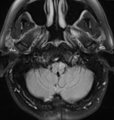 |
Subtle Torsional Pendular Nystagmus in Oculopalatal Tremor (OPT) (Figure 1) | This is a 50-year-old woman who presented with imbalance, and MRI demonstrated a right cerebellar cavernous malformation. She underwent surgery to resect the malformation, and post-operatively experienced right hemiparesis and ataxia. Six months after the surgery, balance worsened and vision became ... | Image |
| 332 |
 |
Summary of the Most Common Audio-Vestibular Testing | Chart describing common audio-vestibular testing. | Text |
| 333 |
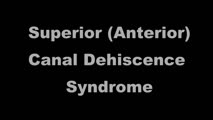 |
Superior Canal Dehiscence | 𝗢𝗿𝗶𝗴𝗶𝗻𝗮𝗹 𝗗𝗲𝘀𝗰𝗿𝗶𝗽𝘁𝗶𝗼𝗻: This is a 60-yo-man who complained of autophony (eg, hearing his own heartbeat, noting that his own voice sounded too loud) and dizziness triggered with loud noises and straining at times. With pinched-nose Valsalva maneu... | Image/MovingImage |
| 334 |
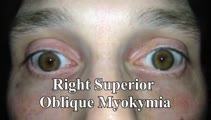 |
Superior Oblique Myokymia (SOM) | 𝗢𝗿𝗶𝗴𝗶𝗻𝗮𝗹 𝗗𝗲𝘀𝗰𝗿𝗶𝗽𝘁𝗶𝗼𝗻: This is a patient with transient monocular oscillopsia OD and vertical diplopia noted to have many episodes of SOM in the office. There was not only myokymia OD, but also a 4 prism diopter left hypertropia during episodes... | Image/MovingImage |
| 335 |
 |
Superior Oblique Myokymia - Three Patients with Recorded Attacks Using VOG and Frenzel Goggles | 𝗢𝗿𝗶𝗴𝗶𝗻𝗮𝗹 𝗗𝗲𝘀𝗰𝗿𝗶𝗽𝘁𝗶𝗼𝗻: Patients with superior oblique myokymia (SOM) commonly present with complaints of monocular oscillopsia and/or vertical diplopia, which are related to the primary and secondary actions of the SO (incycloduction and depres... | Image/MovingImage |
| 336 |
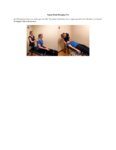 |
Supine Head-Hanging Test | The supine head-hanging test is more sensitive for AC-BPPV, but it does not differentiate laterality, as both canals are stimulated at the same time [1-3]. When the individual returns to a seated position, the otoconia should hypothetically move closer to the utricle, which continues their ampullofu... | Text |
| 337 |
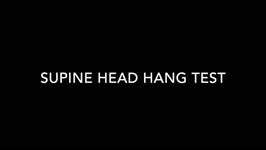 |
Supine Head-Hanging Test (Video) | The supine head-hanging test is more sensitive for AC-BPPV, but it does not differentiate laterality, as both canals are stimulated at the same time [1-3]. When the individual returns to a seated position, the otoconia should hypothetically move closer to the utricle, which continues their ampullofu... | Image/MovingImage |
| 338 |
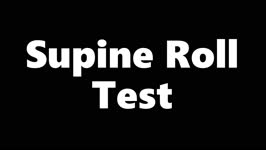 |
Supine Roll Test | Supine roll test: used to test for horizontal canal (HC) BPPV. While horizontal nystagmus due to HC-BPPV is often seen with DH, the roll test will usually maximize nystagmus and vertigo with the HC variant. The patient can be guided through a self-administered supine roll test while lying on the flo... | Image/MovingImage |
| 339 |
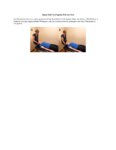 |
Supine Roll Test/Pagnini-McClure Test | The supine roll test or the Pagnini-McClure Test is used to assess for horizontal canal benign paroxysmal positional vertigo. A test is positive when a patient reports vertigo, dizziness, or sensation of movement or falling with nystagmus present. Apogetropic nystagmus is indicative of cupulolithias... | Text |
| 340 |
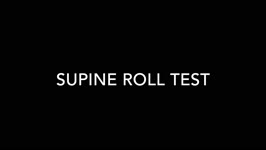 |
Supine Roll Test/Pagnini-McClure Test (Video) | The supine roll test or the Pagnini-McClure Test is used to assess for horizontal canal benign paroxysmal positional vertigo. A test is positive when a patient reports vertigo, dizziness, or sensation of movement or falling with nystagmus present. Apogetropic nystagmus is indicative of cupulolithias... | Image/MovingImage |
| 341 |
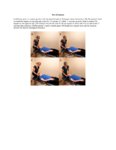 |
Test of Latency | The Test of Latency is used to identify which side is involved for patients with horizontal canal BPPV and is used in conjunction with the Supine Roll Test. For canalithiasis, lateralization is considered the side with a shorter latency time. For cupulolithasis, lateralization is considered the side... | Text |
| 342 |
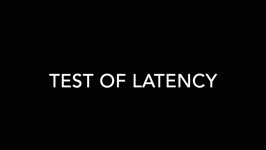 |
Test of Latency (Video) | The Test of Latency is used to identify which side is involved for patients with horizontal canal BPPV and is used in conjunction with the Supine Roll Test. For canalithiasis, lateralization is considered the side with a shorter latency time. For cupulolithasis, lateralization is considered the side... | Image/MovingImage |
| 343 |
 |
Test Your Knowledge - Acute Prolonged Vertigo | This is a 60-year old man with diabetes presenting with acute onset prolonged vertigo that was ongoing at the time of this examination. Which of the following statements are true with regard to the localization and/or etiology of this patient's symptoms? A. Whether or not symptoms worsen with head ... | Image/MovingImage |
| 344 |
 |
Test Your Knowledge - Bilateral 4th Nerve Palsies | Watch the video until instructed to stop. Which of the following features is likely to be present given her exam findings? A. Gaze-evoked nystagmus and impaired smooth pursuit B. History of traumatic brain injury C. History of blepharoplasty or brow lift surgery and prominence of superior sulcus on ... | Image/MovingImage |
| 345 |
 |
Test Your Knowledge - Central and Peripheral Vestibular and Ocular Motor Signs Due to a Large Vestibular Schwannoma | Which of the following is least likely to be the correct localization or etiology given the findings seen in the video? 1) Acute right 8th cranial neuropathy 2) Right-sided vestibular schwannoma 3) Right vestibular nucleus infarction 4) Right anterior inferior cerebellar artery distribution stroke A... | Image/MovingImage |
| 346 |
 |
Test Your Knowledge - Monocular Oscillopsia | 𝗢𝗿𝗶𝗴𝗶𝗻𝗮𝗹 𝗗𝗲𝘀𝗰𝗿𝗶𝗽𝘁𝗶𝗼𝗻: Which of the following associated signs is most likely to be seen in this patient presenting with oscillopsia? A. Optic nerve pallor B. Palatal tremor C. Severe unilateral cataract D. Head bobbing E. Neurovascular contact... | Image/MovingImage |
| 347 |
 |
Test Your Knowledge - Ocular Tilt Reaction and Subjective Visual Vertical | Lesions of which of the following neuro-anatomic structures could result in the clinical findings shown? A. Right medulla B. Right interstitial nucleus of Cajal C. Right medial longitudinal fasciculus D. Left trochlear nerve E. Right caudal midbrain A. Correct. This patient presents with elements... | Image/MovingImage |
| 348 |
 |
Test Your Knowledge - Optokinetic Nystagmus with a Parietal Lesion | 𝗢𝗿𝗶𝗴𝗶𝗻𝗮𝗹 𝗗𝗲𝘀𝗰𝗿𝗶𝗽𝘁𝗶𝗼𝗻: Given the finding seen in the first part of the video, which of the following associated features are most likely? (more than one answer may be correct) A. Left homonymous visual field defect B. Right homonymous visual fi... | Image/MovingImage |
| 349 |
 |
Test Your Knowledge - Oscillopsia | This 65-year-old man with multiple sclerosis described that objects in front of him appear to spontaneously jump or move horizontally for the last few months. He reported that his symptoms occur independent of head movements and head impulse testing was normal. After viewing the video, what is the m... | Image/MovingImage |
| 350 |
 |
Test Your Knowledge - Parinaud's Syndrome in Neurosarcoidosis | Watch the first segment of the video up to "Stop! What would you expect with vertical gaze?" and select the best response below. The patient also has mild right-beating nystagmus which can be ignored for the purposes of this question. A. The patient has pupillary findings consistent with bilateral 3... | Image/MovingImage |
